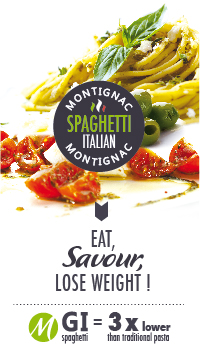Warnings on the Misinterpretation of the Glycemic Index Concept
Glycemic Indexes (GI) correspond to average values!
GIs are first and foremost an average of the individual glycemic responses of groups of people. GIs are also average values of the different foods belonging to the same category.
The GI for cereals will be estimated differently, depending on (fiber, protein …) content which corresponds in its turn to the specific variety of cereal.
Value tables indicate average values and in some cases even variations for the same foodstuff. The GI for white flour, for example, is 69 (±6) which means that the flours tested were maximum 75 and at the lowest at 65.
GI estimates are thus necessarily approximate figures. This means that we should realize that it serves as an indication to guide our choices.
GIs are indicative values and not necessarily exact values. This is why, to simply matters, the Montignac Method uses GI values which correspond to rounded-out averages.
We must be careful not be confused by the some author’s erroneous use of GIs.
GIs are generally classified into three categories:
High, intermediate and low
Most authors assume that:
- GIs below 55 are low;
- GIs ranging from 55 to 69 are intermediate;
- GIs above 70 are high.
The fact is that this ranking does not fit physiological reality. It is simply “politically correct” insofar as it has been arbitrarily construed to satisfy the food industry by not classifying most of its foods in the high GI range.
It has also been designed with the aim of not rocking the boat for traditional nutritionists whose dietary recommendations (potatoes, cereals…) would have suddenly fallen under the ranking of (chancy) high GI foods had GI ranges been objectively determined.
This is why we should be careful and not blindly accept GI tables found in some books and websites since they are often built upon mistaken criterion. Lack of scientific knowledge on what makes GIs leads these authors to simply copy what has been said elsewhere, without any consideration to whether the information was inspired by financial goals rather than scientific findings.
The classification which truly responds to digestive physiology is as follows:
- Low GIs are below or equal to 35
- Intermediate GIs range between 35 and 50
- High GIs are above 50
We can also define this classification by saying that:
- Low GIs are below 50, keeping in mind that very low is below 35;
- High GIs are those above 50
We must pay attention to contradictory information to be found in certain tables!
When Glycemic Indexes were discovered, two methods were proposed to estimate GI value tables.
Certain researchers have designed GI tables by assigning the 100 value to white bread while most assigned the 100 reference value to glucose. The former are necessarily mistaken since the reference for their estimates is a variable value, bread’s GI can vary depending on where the wheat came from, the flour milling and the fermentation and cooking process.
Glucose, comparatively, is the best reference since it systematically provokes the same physiological reaction which corresponds to a 100% intestinal absorption.
Unfortunately, these GI tables which contain values estimated through diverging modes are all confusedly available on paper but even more so on the Web and there is basically no way of knowing where their information came from. What’s even worse is that we often find tables where values from different sources are all mixed up. In these cases, the resulting tables are even more contradictory.
We recommend that users check that the information they use is scientifically referenced and not from a mixture of unknown sources.
Below we propose a GI table. Although thorough, it does not pretend to be completely exhaustive and the definite GI table. It has been established on the basis of diverging values obtained through numerous scientific studies from which the corresponding averages have been estimated.
Michel Montignac’s readers might be surprised to find that certain values differ from those found in certain books. They might be surprised that unsweetened whole-wheat cereals, for example, have a 45 GI while, in some books they are still ranked at 40 GI. The reason for this is simply that for a long time we did not have the studies we have now. Research done has made it possible to assign new and more precise GI values and averages. Thus, certain foods might now appear with lower or higher GIs. We are continuously updating the values indicated in accordance with the complementary information as it becomes available. This updated information is also to be found in the more recent editions of Michel Montignac books.
Top of page




